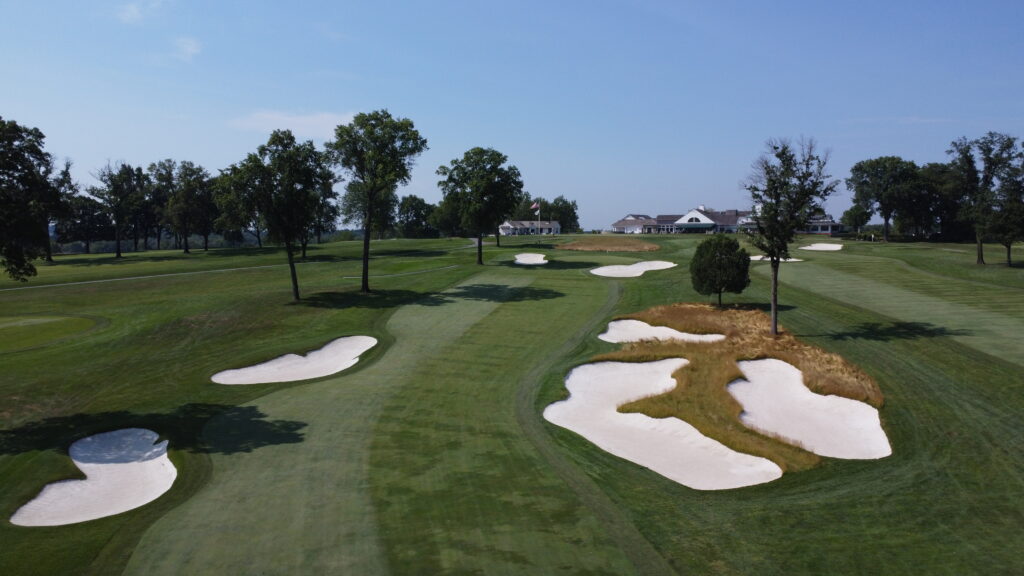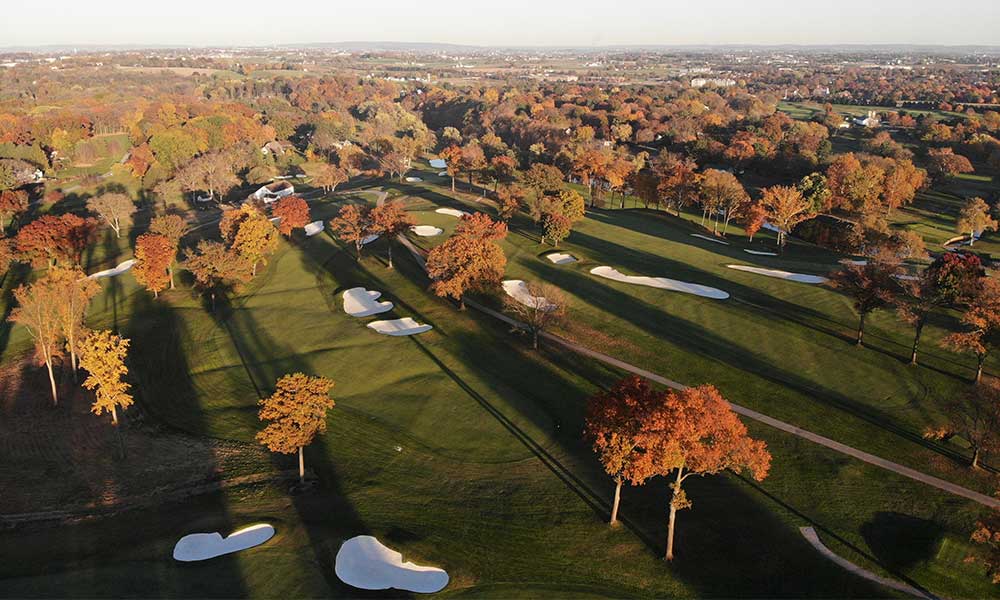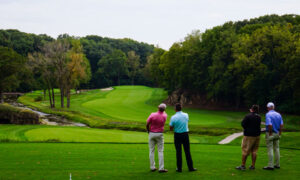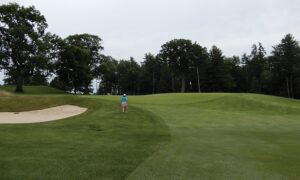Josh Saunders, director of golf course operations at Lancaster Country Club in Pennsylvania, which, at the end of May, will host the US Women’s Open for the second time, interviewed for his job in late 2018. “I remember saying to the selection committee, ‘Do you realize what you have here?’,” he says. And, though today’s level of interest in the history of golf architecture is way higher than it was two decades ago, Lancaster does appreciate, and has for some time, appreciated the gift that club forefathers, along with the legendary course designer William Flynn, gave it. Sixth in its state, according to Golf magazine might not sound like the most exciting ranking ever, but when two of the courses above you are Oakmont and Merion (East), perennially among the top ten in the nation, the truth starts to become a little more evident. Lancaster may only be a small city an hour and a half west of Philadelphia, but, as its status as one of America’s oldest, and for a day during the Revolution the nation’s capital hints, it punches way above its weight. The same might be said for the golf course.
Lancaster Country Club was founded in 1900, but its journey to greatness really started in 1919, when long-time greens chairman Roy Eshelman invited William Flynn, still in his late twenties, and only at the beginning of his great career, to expand the course from nine holes to eighteen, using a newly acquired property. Flynn’s relationship with Lancaster lasted for the rest of his life – he continued to tweak the course until his death in 1944. “When you look closely at Lancaster, it is easy to see the process of Flynn maturing as a designer,” says Lancaster’s consulting golf course architect, Jim Nagle of Forse Design, who has worked with the club since 2004. Architect Brian Silva built the Highlands nine for the club in the early nineties. The club is very conscious of its status as one of Flynn’s most heralded designs. “Any time we touch the course, we are asking ourselves ‘Is this in keeping with the maximum presentation of William Flynn’s strategic intent?’ and ‘Are we working with the lightest hand possible?’, says Rory Connaughton, the club’s greens chair. And this determination to stick with Flynn’s ideas can be seen in the development of Lancaster’s course over the last twenty years.
FROM 2004 to 2015
“When we started working here in 2004, the first thing we did was to rebuild the twelfth and thirteenth greens and associated bunkers, and also the bunkers on the par three seventeenth,” says Jim Nagle. “It was a pilot project of sorts, and it led to us rebuilding the rest of the bunkers on the Old course, which we did in 2006 – it reopened in 2007. Then, in 2011, the greens were cored out to a depth of six inches and regrassed with a new variety of bentgrass. Following the work on the greens, we began developing plans for the development of a new practice facility with a large putting green and a short game area that included two greens and bunkers. This project was completed in 2013.”
2015 US WOMEN’S OPEN
Lancaster held its first Major championship from July 9-12 2015. The tournament, which carried a then women’s golf record purse of $4.5 million, attracted 135,000 spectators, a Championship record. The then twenty year old In Gee Chun of South Korea won the championship, her first Major, with a score of 272, eight below par, shooting rounds of 68 and 66 over the weekend.
“When In Gee won the Open in 2015, she was totally unknown to the American golf audience and she didn’t speak much English,” says Rory Connaughton. “She contacted someone about making a – large – contribution to a local cancer center after the tournament. It was out of nowhere – nobody had any expectation of that. She became very friendly with a member of our club, and that brought her and the club into regular and close contact, and what started as a conversation about memorabilia from the Championship turned into a serious discussion about working with the club to support the local community. Helping others get an education has always been important to In Gee, and quite quickly, what emerged from those discussions was that she and the club would create a foundation whose goal was to help fund education for people connected with the club, including caddies, employees and their children. She contributes a substantial sum of money to it each year, and she comes to the club regularly – she is an honorary member, and she practices here for a few weeks each year. When she won the Women’s PGA Championship at Congressional in 2022, she was here the next day hosting a clinic and fundraising for the foundation. She is a beautiful person inside and out, and we are very proud to be connected with her.”
SINCE 2015
“In the twenty years since we first started working at Lancaster, I believe there has one been one year that we didn’t have a paid consulting visit,” says Jim Nagle. “Lancaster has been a club that has always been proactive on managing its golf course. Some years, it might have been as little as reworking a couple of forward tees or tree management; other years we did much more. But it was always with a very close focus on what Flynn did there, and on retaining his influence and style on the golf course.”
“We see ourselves as a venue for championship women’s golf,” says Rory Connaughton. “Maybe 25 years ago the course could have stood up to the best men, but now, even if we aspired to a men’s major, the market is probably too small. The area, community and club embraces women’s sport, and our club has seen it as a great opportunity to be a community asset. The USGA estimates a $25-$30 million economic impact from a Women’s Open, and for a community like ours, that is a big thing.”
While holding fast to Flynn’s principles, the Lancaster course has been transformed since 2015. “Jim wants to protect the history, but he understands the ever-changing nature of the game,” says Josh Saunders. “Women’s golf has dramatically improved since 2015, and so the course is going to be stretched out, a lot longer than the last time. The greens are a lot firmer than they were, and for the Open it is going to be really, really firm. And we have removed quite a few trees to create a great amphitheatre. You can stand by our clubhouse and see fourteen greens.”

In 2016, Nagle led a project on the club’s third nine, the Highlands course, with the aim of making it look more like the main eighteen. “Jim was asked to take the Silva nine and do a design exploration that would make it at least appear to be more Flynn-like,” says Connaughton. “The Silva bunkers were small scale and many didn’t fit the rest of the course. Jim turned a lot of bunker complexes into single bunkers, flashed them and pulled them into the fairway and create angles more akin to what you would see on a Flynn course. The way that the bunkers now come towards you, a lateral miss is not necessarily the one that will get you – the miss that will get you is the shaped shot that isn’t quite good enough.”
Also in 2016, the club installed a new irrigation system on the main course, and this was accompanied by some new tees and the adjustment of fairway mowing lines. What followed the next year, though, was rather more significant.
“In 2017, the club began conversations about a large facility upgrade – racquets, pool, parking, clubhouse,” says Nagle. “Up till that time the pro could not see the first tee or eighteenth green from his shop. Logistically, moving people, caddies, around was a mess. When the club decided to relocate its pool, that created an opportunity, so we decided to keep the pool house and make it the new pro shop. Work on the facility and the new practice putting green began in 2018. Now we have a large open area where the pool was, next to first and fifteenth tee. We built a 14,000+ sq ft putting ‘playground’, right out in front of the clubhouse, with a fire pit and outdoor dining. That allowed us to eliminate the practice putting green we had built in 2013.
“As we were working on the putting green, we started focusing again on the bunkers on the Flynn course. Also looking at the need to make some adjustments, some restorative, others that were new, but inspired by Flynn’s design tendencies. We could have made a number of bunkers larger, but with water flow and topographic restrictions, we were not able to. Ten holes were altered in terms of bunker placement, orientation or new bunkers – to cope with the way the game was changing. On holes two and nine, which are parallel, we restored Flynn features including conjoined fairways and a shared bunker.
“We restored the eleventh hole. Flynn loved his long par fours; the earliest scorecards we saw had the hole playing 476 yards. It is a great classic hole – drop tee shot, then back up to elevated green, one of the best holes – and best greens – on the golf course. Placement of the approach shot is key – you can’t just go straight at the pin. The front right side of the green is joined to the back of the fifteenth green, as was originally the case, revealed by older aerial photos. We reinstated a bunker in the left rough that is visually impactful from the tee. There is a sizeable landing area, but the restored bunker affects your view. It is a great illustration of Flynn’s less is more design philosophy.
“The thirteenth is a shortish par five. Because of a copse of trees on the inside of the approach, it was a one-dimenional hole – you needed to lay up short of the corner. We could not eliminate the trees completely because of safety issues with the seventeenth tee, so instead, we built a bunker complex – which replicates the one that used to sit in front of the seventeenth green when the hole played as a short par four – to reinforce the hole’s strategy, which is that a play close to OB on the right is optimal. Partial tree removal gave the opportunity to go for the green in two, and the fairway is narrowed at the layup point to encourage that thinking.
“Before the work, the fourteenth hole had two bunkers fifty yards apart on the outside of the dogleg with a larger single bunker to the inside right. We pulled inspiration from Shinnecock and other Flynn courses, and added two more bunkers and fine fescue around the bunkers. The purpose was to reinforce playability of the hole from the fairway. Members were deliberately playing into the rough, which is obviously undesirable from an architectural point of view.”
Most recently, the bunkers on the Old course were rebuilt in 2021 and 2022. “They were ageing, and the liner in them was failing, so it was time to redo them,” says Nagle. “With the Open slated for 2024, the work needed to be done then.”
“We think strategically, with a long-term view in mind,” says Josh Saunders. “During our last bunker project, we restored eleven of Flynn’s original bunkers. With his greens, there is so much undulation that they can present a championship test even if they are not rolling brutally quickly. He used the landforms as they were; he didn’t try to manipulate things very much. His greens generally have three high points, and are thus extremely contoured.”
Related: Lancaster prepares for 2024 Women’s Open with Capillary Bunkers
“We are absolutely not flattening our greens to accommodate higher green speeds,” says Connaughton. “We are determined to remain relevant as a host for top level women’s events, and the contours of the greens are an essential part of that. The as-designed and as-built from 1919 and 1941 are not exactly the same. The location of bunkers now is closer to what Flynn left at his death.”
“Flynn always had his features in front of you, in sight. You have to pick how you want to play a hole,” says Nagle. “When you look at the aerials you start with some basic stuff, such as three mounds bordering the left side of the fifteenth green or with a single bunker set 12-15 feet below the back of the original eighth green (which no longer exists). You see his maturing as a designer evolving at Lancaster. Lancaster has never done an enormous project at one go – but over the years they have invested a significant amount. It shows their determination to keep the course relevant and tournament-ready. None of the work has ever been done because of the hosting of the Women’s Open, it has always principally been about enhancing the member experience. Hosting two Opens in nine years might have affected the timing – but not the actual work.”
About the Lancaster Country Club
Founded in 1900, the Lancaster Country Club is a twenty-seven hole golf facility. William Flynn designed and modified the 18-hole Flynn or ‘Old’ Course between 1919 and his death in 1945. The nine-hole Highlands course, designed by Brian Silva and completed in 1993 was renovated by Forse Design in 2016. In addition to hosting the US Women’s Open in 2024 and 2015, the Club has hosted USGA qualifying events, the 2014 Western Women’s Amateur, the 2013 AJGA Rolex Tournament of Champions and multiple Pennsylvania Open and Amateur Championships, the most notable in 1948 when club member H. H. Haverstick defeated Arnold Palmer by four and three on his way to the championship.
About Forse Design
We are practitioners of time-honored, classic golf architecture. Since1989 we have produced restorations, renovations and new golf course design projects. Additionally, a number of our projects were designed to deliver championship caliber competition as evidenced by the multitude of USGA national championships hosted by courses in our client portfolio.
We strive to craft great courses that reward smart and strategic play across a spectrum of handicaps and capabilities. We want our work to be enjoyed. Players should be inspired to explore the art of shot-making by employing a mix of shots and approaches to different types of holes. Nobody playing a Forse Designed course should ever be “bored with the game”.
Players should find intrigue and inspiration thru experimentation. There will be some risk and reward as well as some options that are pure fun. Not unlike a great music composition, a well designed golf course incorporates elements to be unveiled, discovered, conquered and enjoyed.
We compose variations on strong themes.



























